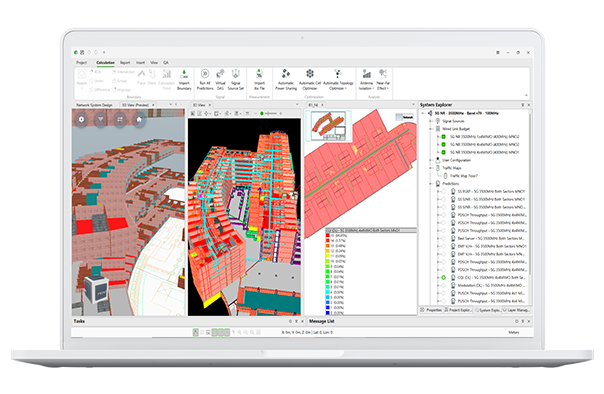Upgrading Your Public Safety Communications System: The Benefits of Aligning TETRA with 4G/5G

The Evolution of TETRA Networks
For decades, TETRA networks have been a staple in public safety, transportation, and utility sectors. They offer reliable voice communications and basic data services that meet the needs of these industries. However, as the digital age continues to reshape our world, the limitations of traditional TETRA networks are becoming apparent:
- Limited Data Speed: TETRA networks primarily support voice communication, making them ill-suited for handling large volumes of data or multimedia content.
- Data Compatibility: With the increasing reliance on data-driven applications, the need for seamless integration of data services with existing TETRA networks has grown.
- Scalability: Traditional TETRA networks face challenges in scaling up to meet the demands of modern communication system
The Solution: Integrating 4G/5G Technology
To address these limitations and enhance mission-critical communication capabilities, integrating 4G and 5G technologies into TETRA networks presents a compelling solution:
- Faster Data Speeds: 4G and 5G networks offer significantly faster data speeds, enabling real-time sharing of high-quality video, images, and other data-intensive applications that are invaluable in emergency situations.
- Enhanced Multimedia Support: The integration of 4G and 5G technologies enables multimedia-rich applications such as video conferencing, live streaming, and augmented reality, which can aid first responders in assessing situations and making informed decisions.
- Greater Network Resilience: By combining TETRA's robust voice capabilities with 4G/5G's redundancy and network resilience, mission-critical communication networks become more dependable and resilient to disruptions.
- Improved Coverage: 4G/5G networks extend coverage in urban, rural, and remote areas, ensuring that first responders can effectively communicate no matter where they are located.
Challenges and Considerations
While the integration of 4G/5G into TETRA networks offers numerous advantages, it also presents challenges that need to be addressed:
- Compatibility: Ensuring seamless interoperability between TETRA and 4G/5G technologies requires careful planning and investment in infrastructure upgrades.
- Reliability: Maintaining the reliability of the higher frequency signal for mission-critical communications during the transition and beyond is paramount.
- Security: Public safety agencies must prioritize network security to protect sensitive information and maintain the integrity of communications.
- Cost: Implementing 4G/5G technology can be expensive, and public safety organizations need to secure funding to make the transition.
- Training: First responders will require training to effectively utilize the enhanced capabilities of the integrated network.
The benefits of upgrading to 4G/5G technology are clear, and those who embrace it will be better equipped to keep people safe and informed during times of crisis.
Public Safety Programs
In North America, initiatives like FirstNet (First Responder Network Authority) have already been implemented to develop and manage a dedicated public safety broadband network that provides maximal capability, cost-efficiency, quality, and serviceability. However, the European Union has yet to fully embrace these programs, despite the eruption of a full-scale war on its doorstep.
As we look ahead, we anticipate several high-profile initiatives being announced, aiming to harness the power of 4G and 5G networks to attain and sustain a competitive edge, that incorporates resilience and resistance to cyber-attacks. To stay ahead of the curve, it's essential that we embrace this new technology and stay up to date with the latest developments in communication systems.
Planning Public Safety Networks
With the shift to new technologies, network planning software plays a crucial role in developing and maintaining integrated public safety networks. Here are a few reasons why:
Optimised Coverage and Capacity: Network planners can use 3D RF simulations to ensure sufficient and seamless signal strength indoors and outdoors, improving communication and coordination between emergency response teams.
Improved Reliability: By analysing network parameters and potential points of failure, network planning software helps enhance the reliability of public safety networks. This reduces the risk of network outages during critical situations.
Interoperability: Public safety networks often involve multiple agencies and technologies. Network planning software can facilitate interoperability by ensuring that different communication systems can work together seamlessly during joint operations or emergencies.
Cost Reduction: Public safety agencies can save on capital and operational expenses by modelling various scenarios and optimising network design. This includes efficient use of existing infrastructure and making informed decisions about network expansion.
Compliance and Reporting: The software can help agencies meet regulatory requirements and reporting obligations by providing documentation of network performance and compliance with standards.
By utilizing Ranplan's cutting-edge network planning and optimisation software, you have the power to simulate the exceptional performance of a brand-new critical communication system integrated with 4G/5G technology. This transformative approach not only empowers you to fully exploit the myriad benefits that 4G and 5G offers but also facilitates substantial cost savings, with the potential to reduce CAPEX by a remarkable 30%. These savings can be achieved before any equipment purchases are made or your network is deployed, ensuring a cost-efficient and forward-looking strategy for your state-of-the-art critical communication network.
Ranplan Wireless has firmly established itself at the forefront of AI-powered data-driven network planning and optimization software. In a world where connectivity and communication have become the lifeblood of our increasingly digitized world, Ranplan's innovative solutions are enabling the way we design, deploy, and manage all wireless networks.
Author:

Ensure dependable, life-saving communications with Ranplan’s advanced public safety network planning tools



